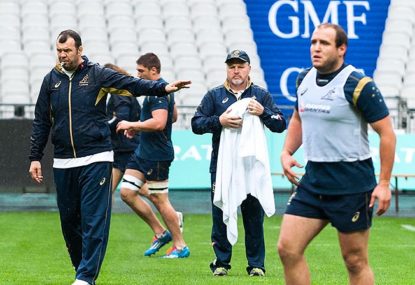When you live and drive in a country like Malaysia, you can do one of two things.
You can play by the official rules and get backlogged in a stockpile of vehicles in front of you.
The other way is to ‘go native’. The same can be said for Michael Cheika’s Wallabies against Ireland.
If you can’t beat them join them
The best way to make progress is not to overtake the car in front of you, but to adopt creative ways to beat those further afield.
By intelligently beating the team that beat the All Blacks, Ireland has snuggled themselves into the ‘Big Three’. They now have an opportunity to drive a stake through the heart of Cheik-ball and the Wallabies, before having another crack at the All Blacks.
Has Ireland Cheik-mated the Wallabies?
Cheik-ball, when implemented well, is one of the most exciting things in world rugby. Every collision is brutal. Every cleanout is drama. Every incursion by the backs is thrilling.
It works like a giant wrecking ball. It is heavy. It is dangerous. It needs precise control from the pivot. It cannot have any weak links in the chain. The pivots must be pin-point and clinical.
But the Wallaby pack is not heavy, with a diminutive backrow and an average tight-five. As a result, the Wallabies possess a ‘ball-and-chain’ of the prison variety instead of the intended wrecker.
Joe Schmidt must be licking his chops. He will look to adopt the Cheik-ball killer set by France – rush defence. Exploit set piece weakness. Spoil the recycle. Counter attack quickly before the Wallabies re-align. Add a few more surprises. Not hard.
Vacancy position: second fly-half
Michael Cheika is no mug. He knows he needs attack variety. The real Cheik-ball requires two fly-halves. One needs to play flat, working with his scrumhalf to get the team on the front foot. The other needs to play deep to read the game, exploit weaknesses and vary the attack.
The current Wallabies team is missing the second fly-half. This allowed Le Bleus to rush and nullify the wrecking ball. This is why last weekend, the Wallabies had majority of possession and territory and lost the game. The French shoved Australia into a corner, until Quade Cooper arrived and started playing a pivot role – from the wing.
Without a dynamic playmaker, the Wallabies are going into a knife fight without the knife. Cheika needs someone who knows what he wants, and can create the attacking variety. There is only one person who fits this bill – Kurtley Beale. Quade Cooper will probably be able to fit in quite quickly also.
Prioritise defence over scrums against Ireland
Last week, the Wallabies looked as tired as the side that lost against Argentina in Mendoza. Before Argentina, the Wallabies were worn out by an energy sapping saga in Johannesburg, followed by a very different ‘saga’ altogether on the infamous flight to Argentina.
Last week, the tiredness seemed to stem from overtraining, covering areas such as attack, scrum, defence etc.
Cheika cannot overtrain. Fortunately for him, due to injury, the Emerald scrum is weaker. This allows the Wallabies to focus on defence against a varied Irish attack. The Irish attack pattern shares some similarity to the Queensland Reds, using forwards to create momentum, allowing their halves to then create havoc.
The Wallabies defence should work on two things. Firstly, they should expect the unexpected, which means the backs and backrow should nullify tactical kicks and set-piece moves. Secondly, the defensive line should target to disrupt the Irish halves. Last but not least, counter attacks – re-alignment and scrambling.
There is a lot of work to do. So, given limited time, manpower and energy, this should take priority over everything else.
Plucking the four leaf clover – with locks
In this situation, the best way to keep the scrum competitive is not training, it’s selection. The Wallabies and Australia will be well served to pick locks who can scrum successfully at international level.
Another uncharacteristic selection is breakaway, in particular blindside flanker. In this position Michael Hooper, Sean McMahon and Matt Hodgson are too light. This runs contrary to NSW’s championship-winning three-lock model. It is also the same model used by Ewen McKenzie’s Wallabies.
Stopping the Green Machine
Michael Cheika has rung the bell of change. We may see the three-lock solution back in action, to swing the wrecking ball with more force.
But McKenzie’s Wallabies showed the way to defeat the Irish last year by using Cheik-ball: a three-lock approach, a solid five-eighth (Matt Toomua) to take the ball up, and a playmaker (Cooper) in the pocket.
The bookies’ odds are for a famous Irish win. But Cheika has the tools in his possession to ‘upset the upset’ and return Australian back to the ‘Big Three’.





























































































